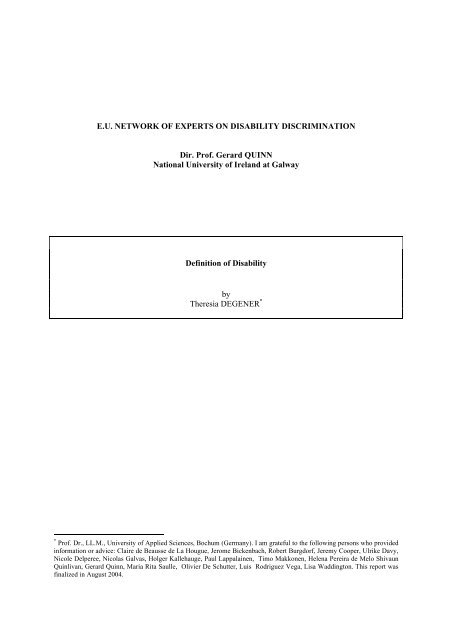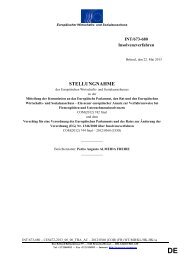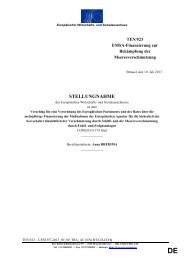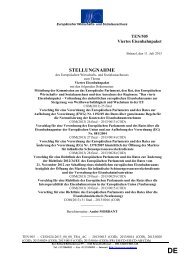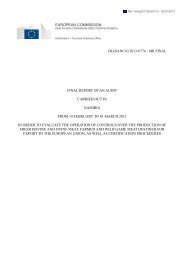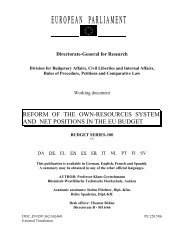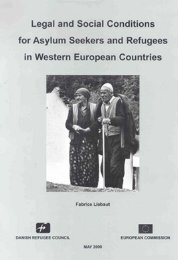Definition of disability
Definition of disability
Definition of disability
You also want an ePaper? Increase the reach of your titles
YUMPU automatically turns print PDFs into web optimized ePapers that Google loves.
E.U. NETWORK OF EXPERTS ON DISABILITY DISCRIMINATION<br />
Dir. Pr<strong>of</strong>. Gerard QUINN<br />
National University <strong>of</strong> Ireland at Galway<br />
<strong>Definition</strong> <strong>of</strong> Disability<br />
by<br />
Theresia DEGENER *<br />
* Pr<strong>of</strong>. Dr., LL.M., University <strong>of</strong> Applied Sciences, Bochum (Germany). I am grateful to the following persons who provided<br />
information or advice: Claire de Beausse de La Hougue, Jerome Bickenbach, Robert Burgdorf, Jeremy Cooper, Ulrike Davy,<br />
Nicole Delperee, Nicolas Galvas, Holger Kallehauge, Paul Lappalainen, Timo Makkonen, Helena Pereira de Melo Shivaun<br />
Quinlivan, Gerard Quinn, Maria Rita Saulle, Olivier De Schutter, Luis Rodriguez Vega, Lisa Waddington. This report was<br />
finalized in August 2004.
This study has been produced under the European Community Action Programme to combat discrimination<br />
(2001-2006). This programme was established by the European Commission's Directorate-General for<br />
Employment and Social Affairs as a pragmatic support to ensuring effective implementation <strong>of</strong> the two<br />
Directives on "Race" and "Equal treatment in the workplace" (2000) emanating from Article 13 <strong>of</strong> the<br />
Amsterdam Treaty. The six-year Programme primarily targets all stakeholders capable <strong>of</strong> exerting<br />
influence towards the development <strong>of</strong> appropriate and effective anti-discrimination legislation and policies,<br />
across the EU-25, EFTA and the EU candidate countries.<br />
The Action Programme has three main objectives. These are:<br />
1. To improve the understanding <strong>of</strong> issues related to discrimination<br />
2. To develop the capacity to tackle discrimination effectively<br />
3. To promote the values underlying the fight against discrimination<br />
http://europa.eu.int/comm/employment_social/fundamental_rights/index_en.htm<br />
As such activities funded under the Programme analyse and evaluate, develop and raise awareness <strong>of</strong> measures<br />
that combat discrimination on the grounds <strong>of</strong> race or ethnic origin, religion or belief, <strong>disability</strong>, age and sexual<br />
orientation. Discrimination on the grounds <strong>of</strong> gender is dealt with under separate legislative instruments.For<br />
more information on Community policies, legislation and activities on gender discrimination, please contact<br />
the Unit for Gender Equality within DG Employment and Social Affairs.<br />
http://www.europa.eu.int/comm/employment_social/equ_opp/index_en.htm<br />
The contents <strong>of</strong> this publication do not necessarily reflect the opinion or position <strong>of</strong> the European Commission<br />
Directorate-General Employment and Social Affairs. Neither the European Commission nor any person acting<br />
on its behalf is responsible for the use which might be made <strong>of</strong> the information in this publication.<br />
To contact the "Anti-discrimination and Relations with the Civil Society" Unit:<br />
Barbara Nolan<br />
Head <strong>of</strong> Unit<br />
Unit D3<br />
200 rue de la Loi<br />
B-1040 Brussels<br />
Belgium<br />
Email:<br />
empl-antidiscrimination@cec.eu.int<br />
2
TABLE OF CONTENTS<br />
I. Introduction.......................................................................................................................................... 4<br />
II. Legal <strong>Definition</strong>s <strong>of</strong> Disabilities: Difficulties and Obstacles ............................................................. 4<br />
III. Disability Discrimination Law: Endorsing the Social Model <strong>of</strong> Disability or Perpetuating the<br />
Medical / Individual Model..................................................................................................................... 5<br />
IV. <strong>Definition</strong>s <strong>of</strong> Disability in Laws transposing the Framework Directive in various EU countries... 7<br />
Germany.............................................................................................................................................. 8<br />
Ireland ................................................................................................................................................. 8<br />
Sweden................................................................................................................................................ 8<br />
United Kingdom.................................................................................................................................. 8<br />
Conclusion .......................................................................................................................................... 9<br />
V. Do we need a definition <strong>of</strong> <strong>disability</strong> in discrimination law ?.......................................................... 10<br />
VI. Conclusion ...................................................................................................................................... 11<br />
3
I. Introduction<br />
This paper is about the issue <strong>of</strong> defining <strong>disability</strong> in European discrimination law context. It is based<br />
on the research and discussions which have been undertaken within the European Group <strong>of</strong> Disability<br />
Discrimination Experts. The paper reviews the definition <strong>of</strong> <strong>disability</strong> in <strong>disability</strong> discrimination laws<br />
<strong>of</strong> those EU countries 1 which have transposed the Framework Directive 2000/78/EC by the end <strong>of</strong><br />
2003. The main question <strong>of</strong> this review is whether the various definitions <strong>of</strong> <strong>disability</strong> perpetuate the<br />
medical/individual model <strong>of</strong> <strong>disability</strong> or support the social model <strong>of</strong> <strong>disability</strong>. According to the<br />
medical/individual model <strong>of</strong> <strong>disability</strong> the problems disabled person face in their daily life are mainly<br />
caused by their impairment, whereas the social model locates the problems in societal and<br />
environmental barriers outside the individual disabled person. The paper examines whether<br />
impairment related definitions <strong>of</strong> <strong>disability</strong> in <strong>disability</strong> discrimination laws perpetuate the medical<br />
model <strong>of</strong> <strong>disability</strong>. Secondly, the paper discusses whether a definition <strong>of</strong> <strong>disability</strong> is necessary within<br />
the context <strong>of</strong> <strong>disability</strong> discrimination law.<br />
Since the Framework Directive only deals with the area <strong>of</strong> employment and occupation, not all<br />
<strong>disability</strong> definitions in EU countries will be addressed. Some EU countries, such as Germany or<br />
Spain, have more <strong>disability</strong> discrimination laws outside the employment area at federal or regional<br />
level, that contain various definitions <strong>of</strong> <strong>disability</strong>. However these discrimination laws cannot be<br />
regarded as transposition laws with regard to the Framework Directive. Similarly, definitions <strong>of</strong><br />
<strong>disability</strong> in other European laws outside the discrimination context are not covered.<br />
II. Legal <strong>Definition</strong>s <strong>of</strong> Disabilities: Difficulties and Obstacles<br />
Legal definitions <strong>of</strong> <strong>disability</strong> have been an issue <strong>of</strong> much debate in Europe and around the globe. 2<br />
Despite the efforts <strong>of</strong> the World Health Organisation which resulted in the new ICF, there is no<br />
international universal legal definition <strong>of</strong> <strong>disability</strong>, neither is there one in any EU country. A recent<br />
study on definitions <strong>of</strong> <strong>disability</strong> in various EU countries has shown that <strong>disability</strong> definitions vary<br />
from country to country but also inside each country. While there are similarities between the<br />
definitions <strong>of</strong> disabilities in some areas <strong>of</strong> social policy, legal <strong>disability</strong> definitions in each country<br />
differs with respect to income maintenance, employment measures or social assistance with daily life<br />
activities. 3<br />
While legal definitions <strong>of</strong> other categories, such as sex, ethnic backgrounds, or sexual orientation also<br />
raise questions <strong>of</strong> demarcation 4 , <strong>disability</strong> is even harder to define because it encompasses numerous<br />
conditions <strong>of</strong> mind and body and the boundary between ability and <strong>disability</strong> seems to be less clear.<br />
Well-known examples are visual and hearing conditions. When does a visual limitation constitute an<br />
impairment? When do we call a person who is hard <strong>of</strong> hearing a disabled person? In addition,<br />
definitions <strong>of</strong> <strong>disability</strong> change according to developments in medical science. New disabilities<br />
1 Out <strong>of</strong> the old fifteen EU countries before May 2004.<br />
2 Jerome E. Bickenbach, “Physical Disability and Social Policy”,, Toronto et.al. University <strong>of</strong> Toronto Press, 1992; Barbara<br />
M. Altman, “Disability <strong>Definition</strong>s, Models, Classification Schemes and Applications”, In: Gary L. Albrecht, Katherine D.<br />
Seelman, Michael Burg, “Handbook <strong>of</strong> Disability Studies”, Thousand Oaks: Sage Publications, 2001, pp. 97-122.<br />
3 Deborah Mabbett, et.al., “<strong>Definition</strong>s <strong>of</strong> Disability in Europe. A Comparative Analysis.”, Final Report 13 December, 2002.<br />
Brunel University, UK ( European Commission ), also on the internet at:<br />
http://europe.eu.int/comm/employment_social/index/complete_report_en.pdf.<br />
4 Martha Minow, “Making All the Difference.Inclusion, Exclusion, and American Law”, Ithaka and London, Cornell<br />
University Press, 1991 ( 2 nd edition ): Juan F. Pereira, et.al., “Race and Races. Cases and Resources for a Diverse America”,<br />
St. Paul, Minn., West Group, 2000, pp. 50-90; Christa Tobler, “How to Use the Experience With Sex Discrimination for the<br />
Other Grounds” in: “Protection Against Discrimination and Gender Equality. How to meet both Requirements”, The Uniform<br />
and Dynamic Implementation <strong>of</strong> EU Anti-Discrimination Law: The Role <strong>of</strong> Specialised Bodies Report <strong>of</strong> the Second<br />
Experts` Meeting, 20-21 May 2003,pp. 14-27.<br />
4
emerge with new medical developments and discoveries. Genetic dispositions to certain diseases are<br />
recent examples.<br />
Legal definitions <strong>of</strong> <strong>disability</strong> vary also in relation to different legal purposes. A social welfare law<br />
providing personal assistance benefits may have a different target group <strong>of</strong> disabled persons than a<br />
discrimination law. The distribution <strong>of</strong> social benefits has to be needs-based in order to be rational.<br />
Equal treatment as a right not a benefit should not be <strong>of</strong>fered only to those in need but to all persons<br />
potentially effected by discrimination.<br />
From a theoretical perspective <strong>disability</strong> definitions are challenged by the debate on what causes<br />
<strong>disability</strong>: medical conditions, environmental factors, social structures and/or individual or collective<br />
behaviors and attitudes. This debate about medical (individual) vs. social model <strong>of</strong> <strong>disability</strong> has had a<br />
large impact on European <strong>disability</strong> policy because it has led to the paradigm shift from charity-based<br />
to rights-based <strong>disability</strong> policy and it has helped to understand <strong>disability</strong> as a social construct.<br />
III. Disability Discrimination Law: Endorsing the Social Model <strong>of</strong> Disability or Perpetuating the<br />
Medical / Individual Model<br />
Discrimination Law has the purpose to prevent unequal treatment which is rooted in stereotypes and<br />
stigma. With respect to <strong>disability</strong>, neglect <strong>of</strong> <strong>disability</strong> as a human difference has been analyzed as the<br />
third source <strong>of</strong> <strong>disability</strong> discrimination. 5 In the employment sector stereotypes about disabled persons<br />
range from the view that disabled persons are unable to work or unable to compete in the open labor<br />
market, to the opinion that a disabled worker disturbs the normal process <strong>of</strong> work in any enterprise, if<br />
not being a health and safety hazard to other employees.<br />
Disabled workers are stigmatized as unproductive and economically undesirable. The fact that most<br />
work sites and work environments are inaccessible to many disabled employees is the result <strong>of</strong> neglect<br />
<strong>of</strong> disabled persons needs.<br />
Disability discrimination law sends a powerful message to the general public. It is based on the<br />
assumption that discrimination is wrongful and a major problem for disabled persons. The latter are<br />
seen not as problems but as right holders. Disability discrimination law, thus endorses the social model<br />
<strong>of</strong> <strong>disability</strong> because it locates the problem <strong>of</strong> <strong>disability</strong> outside the individual person. 6 Discrimination<br />
law neatly fits with an understanding <strong>of</strong> <strong>disability</strong> as a social construct. It can help to deconstruct the<br />
medical/ individual model <strong>of</strong> <strong>disability</strong> and the stereotypes that come with it.<br />
At the same time law is <strong>of</strong> course a tool to construct social reality in modern society. Thus, it is clear<br />
that every legal definition <strong>of</strong> <strong>disability</strong> takes part in the social construction <strong>of</strong> <strong>disability</strong> 7 . The question<br />
then arises, whether legal definitions in discrimination law reinstate or perpetuate the individual<br />
model <strong>of</strong> <strong>disability</strong>? In Germany, where we had over twenty <strong>disability</strong> discrimination laws adopted<br />
over the course <strong>of</strong> the last decade, members <strong>of</strong> the <strong>disability</strong> movement <strong>of</strong>ten demanded that <strong>disability</strong><br />
should not be defined as a medical condition, notably an impairment. Only non-medical definition, it<br />
was argued, could endorse the social model <strong>of</strong> <strong>disability</strong>. Similar debates took place in other countries<br />
and in international legal context. 8 But the social model <strong>of</strong> <strong>disability</strong> does not give any guidance as<br />
5 Samuel R. Bagenstos, “Subordination, Stigma, and `Disability`”, 86 Virginia Law Review, 2000, pp. 397-534.<br />
6 For a detailed recent discussion <strong>of</strong> the social model <strong>of</strong> <strong>disability</strong> see: Colin Barnes, Ge<strong>of</strong> Mercer ( eds ), “Implementing the<br />
Social Model <strong>of</strong> Disability”: Theory and Research, Leeds, The Disability Press, 2004<br />
7 Deborah A. Stone ( in: Samuel R. Bagenstos, “Subordination, Stigma and `Disability`” ), “The Disabled State“,<br />
Basingstoke, UK, Macmillan, 1985; Philadelphia, (USA ) Temple University Press, 1984; Theresia Degener, “Behinderung<br />
als Rechtliche Konstruktion”, In: Petra Lutz, et.al. ( Hg. ), “Der ( Im- )Perfekte Mensch. Metamorphose von Normalität und<br />
Abweichung”, Koeln ( Germany ), Boehlau, 2003, pp. 448-467; Melinda Jones and Lee Ann Basser Marks, “Law and the<br />
Social Construction <strong>of</strong> Disability” in: Melinda Jones and Lee Ann Basser Marks (eds.) Disability, Divers-ability and Legal<br />
Change, The Hague, et. al: Kluwer Law International, 1999, p. 1-24.<br />
8 Aart C. Hendriks, “Different <strong>Definition</strong> – Same Problems – One Way Out?”, In: Mary Lou Breslin, Silvia Yee ( eds ),<br />
“Disability Rights Law and Policy”, International and National Perspectives, Ardsley ( USA ), 2002, pp. 195-240. It is also<br />
5
how to legally define <strong>disability</strong> alternatively. While the various revised WHO definitions have been a<br />
valuable contribution to the discussion in that it seeks to combine what is true about the medical model<br />
and the social model <strong>of</strong> <strong>disability</strong> and produced the biopsychosocial model <strong>of</strong> <strong>disability</strong>, 9 it seems to be<br />
less useful in the context <strong>of</strong> <strong>disability</strong> discrimination law. This is because the WHO notion <strong>of</strong><br />
<strong>disability</strong> as a result <strong>of</strong> an interaction between an impaired individual and social environment mixes<br />
characteristics and treatment. A discrimination law has to separate these two things by saying which<br />
treatment is regarded prohibited discrimination against whom. Disability discrimination laws thus<br />
need to define discrimination as well as <strong>disability</strong> and it makes no sense to define <strong>disability</strong> as the<br />
outcome <strong>of</strong> discrimination.<br />
Thus, it seems that the solution might not be to refrain from using medical terms or impairment<br />
terminology. Rather the opposite is true if we think about how <strong>disability</strong> discrimination actually<br />
works. Disability- based prejudice and stigma are always related to an actual or presumed abnormality<br />
called impairment or chronic illness. The view that a blind person cannot work as a bank accountant is<br />
based on the assumption that a bank accountant needs (full) vision capacity. The hotel manager who<br />
does not accept disabled guests, assumes that their impaired appearance distracts able-bodied guests.<br />
The impairment may be visible or invisible, it may be real existent or imputed, but it is always the<br />
reference <strong>of</strong> discriminative treatment. Neglect, the third source <strong>of</strong> <strong>disability</strong> discrimination works the<br />
same way. It is neglect <strong>of</strong> differences due to an impairment which results in discrimination. Neglecting<br />
that paralysed people move on wheels instead <strong>of</strong> on legs, or neglecting that blind persons read braille<br />
instead <strong>of</strong> black print leads to inaccessibility and exclusion.<br />
Thus, definitions <strong>of</strong> <strong>disability</strong> in discrimination laws do not perpetuate the individual model <strong>of</strong><br />
<strong>disability</strong> if they refer to impairment.<br />
There are, however other pitfalls for the reinstatement <strong>of</strong> the individual model <strong>of</strong> <strong>disability</strong> in<br />
discrimination laws. One such pitfall are definitions which portray disabled persons as helpless and<br />
incapable with respect to a range <strong>of</strong> normal life activities. A recent OECD study on <strong>disability</strong><br />
definitions has come to a similar conclusion by suggesting that <strong>disability</strong> should not be equated with<br />
employment incapacity. 10 Those definition convey the very same stereotypes about disabled persons,<br />
discrimination law seeks to prevent. One <strong>of</strong> the core values <strong>of</strong> non-discrimination law in the context <strong>of</strong><br />
<strong>disability</strong> is that it creates space for individual abilities despite any group membership Such space can<br />
only be created if <strong>disability</strong> definitions are cleared <strong>of</strong> any assumptions about ability or incapability.<br />
Another pitfall is to narrowly construe the definition <strong>of</strong> <strong>disability</strong> to persons who are severely disabled<br />
or substantially limited in a range <strong>of</strong> daily life activities. Jurisprudence on the American with<br />
Disabilities Act (ADA) has shown that such a definition screens out many disabled person who are<br />
victims <strong>of</strong> discrimination but do not match the “truly disabled” label. 11 To protect only a certain<br />
category <strong>of</strong> disabled persons against discrimination is problematic for a number <strong>of</strong> reasons. In this<br />
paper I will only focus on how such a definition intersects with the medical/ individual model <strong>of</strong><br />
<strong>disability</strong>. Such a narrow definition <strong>of</strong> <strong>disability</strong> is based on the assumption that only severely disabled<br />
persons are in need for anti-discrimination measures. This in turn presumes that <strong>disability</strong><br />
discrimination is actually and only invoked by a certain degree <strong>of</strong> impairment, which again locates the<br />
problem <strong>of</strong> <strong>disability</strong> discrimination inside the individual victim. The opposite is true: <strong>disability</strong><br />
discrimination is the result <strong>of</strong> treatment, attitudes and social structures. Often the impairment <strong>of</strong> the<br />
victim does not matter at all, except for being a vent for prejudice and stigma. These are the cases,<br />
an issue in the current debate on an United Nations Disability Human Rights Convention. The debate and documents can bee<br />
seen at: http://www.un.org/esa/socdev/enable/rights.<br />
9<br />
http://www3.who.int/icf/icftemplate.cfm<br />
10<br />
OECD, “Transforming Disability into Ability: Policies to Promote Work and Income Security for Disabled People”, Paris,<br />
OECD, 2002.<br />
11<br />
Robert C. Burgdorf “`Substantially Limited`Protection from Disability Discrimination: The Special Treatment Model and<br />
Misconstructions <strong>of</strong> the <strong>Definition</strong> <strong>of</strong> Disability”, In: 42 Villanova Law Review, 1997, pp. 409-536; Samuel R. Bagenstos, (<br />
2000 ), Supra note 4, p. 399, Chai R.Feldblum , “<strong>Definition</strong> <strong>of</strong> Disability under Federal Anti-Discrimination Law: What<br />
Happened? Why? And What?” in: Vol. 21 No 1, Berkeley Journal <strong>of</strong> Employment and Labor Law, 2000, pp. 91-165<br />
6
when <strong>disability</strong> should not be taken into account at all may it be severe or less severe. A person with<br />
only one arm may be denied a job as a secretary even though she can perform all the essential<br />
functions <strong>of</strong> the job without any accommodations. Her <strong>disability</strong> should not matter at all. The same<br />
holds true for the applicant who misses only one finger. What is important is not the impairment but<br />
the reaction to it. By obscuring the cause <strong>of</strong> discrimination, narrow definitions <strong>of</strong> <strong>disability</strong> in<br />
discrimination laws indirectly purport the individual/ medical model <strong>of</strong> <strong>disability</strong>. 12<br />
Another, yet similar indicator for the individual model <strong>of</strong> a <strong>disability</strong> definition is, if not all persons<br />
affected or threatened by <strong>disability</strong>-based discrimination are covered by the definition. This group is<br />
much larger than the group <strong>of</strong> persons with present disabilities, because discrimination may be based<br />
on past, present, future or assumed disabilities. The reasons for this indicator are similar to those<br />
already mentioned with relation to a “truly disabled” definition. In addition it can be said, that a<br />
definition that encompasses past, future and assumed disabilities as well as associates <strong>of</strong> disabled<br />
persons is a clear approval <strong>of</strong> the social model <strong>of</strong> <strong>disability</strong> because it is firmly based on a notion <strong>of</strong><br />
<strong>disability</strong> as a social construct.<br />
Finally a definition <strong>of</strong> <strong>disability</strong> in a discrimination law might create tensions with respect to other<br />
social welfare law definitions on <strong>disability</strong>. Again experiences from the US with respect to ADA<br />
implementation can be illustrative. Because disabled employees seeking protection under the ADA<br />
need to bring evidence that they are “otherwise qualified” for the particular employment, they might<br />
face the danger <strong>of</strong> loosing out on <strong>disability</strong> benefits which require recipients to prove that they have<br />
reduced or lost work capacity. 13 Similar conflicts between social welfare and discrimination law have<br />
been predicted for Europe 14 While the tension between these two sets <strong>of</strong> laws might not first <strong>of</strong> all be a<br />
problem <strong>of</strong> different definitions, it should not be ignored in this context. People with disabilities might<br />
have to choose between anti-discrimination or social benefits. Or they might be forced to take up two<br />
roles. One in which they play the capable and qualified disabled employee, and another one in which<br />
they have to play the helpless and needy beneficiary. Such a result would perpetuate the individual<br />
model <strong>of</strong> <strong>disability</strong>.<br />
IV. <strong>Definition</strong>s <strong>of</strong> Disability in Laws transposing the Framework Directive in various EU<br />
countries<br />
Out <strong>of</strong> the fifteen EU Member States under review in our expert group, ten countries have <strong>disability</strong><br />
discrimination laws in the area <strong>of</strong> employment at the time <strong>of</strong> this conference. These are: Belgium,<br />
Finland, Germany, Greece, Ireland, Luxembourg, the Netherlands, Portugal, Sweden, and UK. While<br />
a few countries, such as the United Kingdom, Sweden and Ireland already had these laws before the<br />
Framework Directive was adopted in November 2000, the majority <strong>of</strong> laws were adopted in order to<br />
transpose the Framework Directive. It seems that only four countries, namely Germany, Ireland,<br />
Sweden and the United Kingdom adopted <strong>disability</strong> discrimination laws which entail definitions <strong>of</strong><br />
<strong>disability</strong>. 15<br />
12 Similarly Robert C.Burgdorf, ( 1997 ), Supra note 12, at 536-559; Cheryl Anderson, “’Deserving Disabilities’: Why the<br />
<strong>Definition</strong> <strong>of</strong> Disability Under the Americans with Disabilities Act Should Be Revised to Eliminate the Substantial<br />
Limitation Requirement” in: 65 Missouri Law Review (2000) p. 83 – 150 at note 245; Lisa Eichhorn “Applying the ADA to<br />
Mitigating Measure Cases: A Choice <strong>of</strong> Statutory Evils” in: 31 Arizona State Law Journal (2000) p. 1071 – 1120, at 1112;<br />
Paula Berg, “ Ill/Legal: Interrogating the Meaning and Function <strong>of</strong> the Category <strong>of</strong> Disability in Antidiscrimination Law” in:<br />
18 Yale Law & Policy Review (1999) p. 1 – 51 at 13.<br />
13 Robert Burgdorf (1997) supra note 12 at 1112; Lisa Waddington, Mathew Diller, “Tensions and Coherence in Disability<br />
Policy: The Uneasy Relationship Between Social Welfare and Civil Rights Models <strong>of</strong> Disability in American, European, and<br />
International Employment Law”, In: Mary Lou Breslin, Silvia Yee ( eds. ), “Disability Rights Law and Policy”, International<br />
and National Perspectives, Ardsley ( USA ), 2002, pp. 241-282 ( 252 ).<br />
14 Lisa Waddington , ibid, p. 256.<br />
15 In France, a law has been adopted by the Senate in March this year, but the legislative procedure hasn’t been finalized at<br />
the time <strong>of</strong> the conference . For this reason, the <strong>disability</strong> definition in the French draft bill on “the Equal Rights and<br />
Opportunities, Participation and Citizenship <strong>of</strong> Handicapped People” will not be considered in this paper. The same holds<br />
true for other draft bills in EU countries, e.g. Austria.<br />
7
Germany<br />
In Germany, the legislators decided to transpose the Framework Directive within the context <strong>of</strong> the<br />
new rehabilitation law, which came into force in 2001. The Ninth Book <strong>of</strong> the Social Law Code (SGB<br />
IX) encompasses a prohibition for all employers to discriminate against severely disabled employees<br />
(§ 81 (2) SGB IX). According to § 2 SGB IX persons are disabled if their physical functions, mental<br />
capacities or psychological health are highly likely to deviate for more than six months from the<br />
condition which is typical for the respective age and whose participation in the life <strong>of</strong> society is<br />
therefore restricted. Severely disabled are persons whose degree <strong>of</strong> <strong>disability</strong> is at least 50 % and who<br />
either lawfully stay in Germany, have their ordinary (legal) residence or (legally) work in Germany. (§<br />
2 (2) SGB IX) The percentage <strong>of</strong> a given <strong>disability</strong> is determined according to a list <strong>of</strong> impairments<br />
and diseases 16 and according to guidelines prepared by a group <strong>of</strong> medical and legal experts. 17<br />
Ireland<br />
In Ireland, <strong>disability</strong> discrimination is prohibited by two laws which are not <strong>disability</strong> specific, but<br />
cover several grounds. Employment discrimination is prohibited by the Employment Equality Act <strong>of</strong><br />
1998. Section 2(1) <strong>of</strong> the Act defines:<br />
‘<strong>disability</strong> means-<br />
(a) the total or partial absence <strong>of</strong> a person’s bodily or mental functions, including the absence <strong>of</strong> a<br />
part <strong>of</strong> a person’s body<br />
(b) the presence, in the body <strong>of</strong> organisms causing, or likely to cause, chronic disease or illness,<br />
(c) the malfunction, malformation or disfigurement <strong>of</strong> a part <strong>of</strong> a person’s body<br />
(d) a condition or malfunction which results in a person learning differently from a person without<br />
the condition or malfunction, or<br />
(e) a condition, illness or disease which affects a person’s thought processes, perception <strong>of</strong> reality,<br />
emotions or judgement or which results in disturbed behavior,<br />
and shall be taken to include a <strong>disability</strong> which exists at present, or which previously existed but<br />
no longer exists, or which may exist in the future or which is imputed to a person.<br />
Sweden<br />
In Sweden a <strong>disability</strong>-specific law against employment discrimination was adopted in 1999. The<br />
“Prohibition <strong>of</strong> Discrimination in Working Life <strong>of</strong> People With Disability Act (Lag 1999:132). § 2 <strong>of</strong><br />
the Act contains a short definition:<br />
Disability means every permanent physical, mental or intellectual limitation <strong>of</strong> a person’s<br />
functional capacity that is a consequence <strong>of</strong> an injury or illness that existed at birth, arose<br />
thereafter or may be expected to arise.<br />
United Kingdom<br />
In the United Kingdom, employment discrimination against disabled persons is prohibited by the<br />
Disability Discrimination Act <strong>of</strong> 1995 (DDA) <strong>of</strong> which Section 1 provides:<br />
16 GdB/MdE-Tabelle zu Section 30 Bundesversorgungsgesetz.<br />
17 Bundesministerium für Arbeit und Sozialordnung (Hg.) Anhaltspunkte für die ärztliche Gutachtertätigkeit im sozialen<br />
Entschädigungsrecht und nach dem Schwerbehindertengesetz (1996).<br />
8
a person has a <strong>disability</strong> for the purposes <strong>of</strong> this Act if he has a physical or mental impairment<br />
which has a substantial and long-term adverse effect on his ability to carry out normal day-today<br />
activities.<br />
A long term- effect is considered to be a period <strong>of</strong> twelve months at least.<br />
Section 2 (1) provides:<br />
Conclusion<br />
The provisions <strong>of</strong> this Part and Parts II and III apply in relation to a person who has had a<br />
<strong>disability</strong> as they apply in relation to a person who has that <strong>disability</strong>.<br />
All <strong>of</strong> these definitions are impairment – related. While the general German definition <strong>of</strong> <strong>disability</strong><br />
emphasises the deviation from a typical condition without referring to impairments, the definition <strong>of</strong><br />
severely disabled persons 18 does. The latter one is determined by a list <strong>of</strong> impairments. Accordingly, a<br />
person without four fingers (including a thumb) would be a severely disabled person. The same holds<br />
true for a person without one leg or a person with serious facial disfigurements. The German definition<br />
only covers persons who are presently disabled. 19<br />
The Irish definition, too is impairment – and/or capacity related, but it does not require a certain<br />
severity <strong>of</strong> the impairment or <strong>of</strong> the functional limitation. It covers present, past, future and imputed<br />
disabilities.<br />
The Swedish definition is focussed on functional limitations as the result <strong>of</strong> impairments, but again,<br />
does not require any severity or long lasting condition to be reached. It covers present and future<br />
disabilities.<br />
The British definition is impairment –related and refers to a range <strong>of</strong> normal life activities and long<br />
term effects. The person’s functional limitations need to be substantial. It covers present and past<br />
disabilities.<br />
None <strong>of</strong> the definitions in these four EU countries cover persons who are associated with disabled<br />
persons.<br />
Case law in these four countries 20 reveals that the British definition has been most problematic,<br />
because it installs a high threshold plaintiffs have to overcome in order to receive protection <strong>of</strong> the<br />
law. Similar to the US experiences with the ADA- definition, many plaintiffs loose their cases because<br />
they cannot prove that they belong to the group <strong>of</strong> the “truly disabled”.<br />
Taking into account the guidelines for <strong>disability</strong> definitions described supra, the German and the<br />
British definitions clearly perpetuate the medical/individual model <strong>of</strong> <strong>disability</strong> for several reasons.<br />
Both definitions are narrowly construed towards the “truly disabled” person. They do not cover all<br />
persons affected by <strong>disability</strong>- based discrimination, i.e. not those who might have a future <strong>disability</strong><br />
or who are presumed to be disabled. The German definition additionally ignores past disabilities.<br />
The Swedish definition is less oriented towards the individual model <strong>of</strong> <strong>disability</strong> in that it covers a<br />
broad number <strong>of</strong> disabled people and covers future disabilities. Yet, it covers not all persons who are<br />
or might be victims <strong>of</strong> <strong>disability</strong>-based discrimination, because past and imputed definitions are not<br />
18<br />
And only to this group <strong>of</strong> disabled persons does the discirimination ban apply!<br />
19<br />
The SGB IX also covers „persons threatened by a <strong>disability</strong>“ ( § 2 ( 1 ) SGB IX ), however the ban on employment<br />
discrimination does not.<br />
20<br />
Germany did only have one case so far, which did not involve questions on the definition <strong>of</strong> <strong>disability</strong>.<br />
9
explicitly covered and plaintiffs need to provide evidence that they are somehow unable because <strong>of</strong><br />
mental, physical or intellectual limitations.<br />
The Irish definition seems to circumvent almost all the pitfalls described above. It does not portray<br />
disabled persons as helpless or needy, because it makes no assumptions about the effects <strong>of</strong> a given<br />
impairment or malfunction. It is not based on a “truly disabled” notion and it covers past, present,<br />
future and imputed disabilities. It thus can be regarded as truly endorsing the social model <strong>of</strong><br />
<strong>disability</strong>.<br />
As to the possibility <strong>of</strong> creating tensions with other social <strong>disability</strong> laws, it seems that it is too early<br />
to say anything about this subject relating to the four countries under review here. It might be<br />
predicted though, that the Irish definition will pose the least problems with respect to this issue.<br />
V. Do we need a definition <strong>of</strong> <strong>disability</strong> in discrimination law ?<br />
Since not all EU countries which have adopted <strong>disability</strong> discrimination law have chosen to define<br />
<strong>disability</strong> in this context, the question arises whether this might be a possible solution to the problem.<br />
In other words: does <strong>disability</strong> discrimination law necessitate a legal definition <strong>of</strong> <strong>disability</strong>? The<br />
Framework Directive is silent on this issue. The issue <strong>of</strong> <strong>disability</strong> definition was deliberately left to<br />
the Member States in order to give leeway to use their own nationally developed <strong>disability</strong> definitions.<br />
But the Framework Directive does not demand Member States to define <strong>disability</strong> in the context <strong>of</strong><br />
employment discrimination and at least six EU members have chosen not to.<br />
An argument for the need to define <strong>disability</strong> which has been put forward is that discrimination laws<br />
have the purpose to protect a distinct group which has historically been oppressed by another<br />
dominant group. The definition would then serve as a gatekeeper and clarify which group is to be<br />
protected by the law. Such a “subordination-approach” 21 claims to ensure that only the members <strong>of</strong> the<br />
subordinated group have anti-discrimination rights. There are three counter arguments against this.<br />
First, most discrimination laws do not only cover a distinct subordinated group, because they are<br />
symmetric. The ban on discrimination is based on a neutral category, such as race, religion, or sexual<br />
orientation which allows both groups, the members <strong>of</strong> the dominant as well as the members <strong>of</strong> the<br />
subordinated group to claim protection against discrimination. This <strong>of</strong> course is difficult with respect<br />
to <strong>disability</strong> which is an asymmetric category as such. Some authors have suggested to try to find a<br />
neutral symmetric category for <strong>disability</strong> discrimination, such as the term capabilities. 22 However, to<br />
my view, this is not a neutral category and <strong>disability</strong> discrimination <strong>of</strong>ten has nothing to do with what<br />
the individual can or cannot do.<br />
Secondly, any group definition bears the danger <strong>of</strong> making unfound assumption about each member <strong>of</strong><br />
that group. This essentialist trap 23 can be avoided by focussing on the act <strong>of</strong> discrimination instead <strong>of</strong><br />
on the definition <strong>of</strong> the group. As Jerome Bickenbach and Robert Burgdorf have recently explained to<br />
our expert group, discrimination is an invidious and unjust response to <strong>disability</strong>, so our focus should<br />
be on the nature <strong>of</strong> that response and the disadvantages and inequalities that the complainant suffers as<br />
a consequence, rather than any physiological feature <strong>of</strong> the person themselves 24 .<br />
Thirdly, I agree with Gerard Quinn that the Framework Directive does not create space for groups but<br />
for individuals. Non-discrimination law focuses on the person rather than the group to which s/he<br />
21 Samuel Bagenstos, ( 2000 ), supra note 4 at 401; Similar Harlan Hahn, “Accommodations and the ADA: Unreasonable<br />
Bias or Biased Reasoning?”, in: Vol 21 N°1, Berkeley Journal <strong>of</strong> Employment and Labor Law, 2000, 166 ( 176 ); much<br />
earlier with respect to sex and race discrimination: Ruth Colker, “Anti-Subordination Above All: Sex, Race and Equal<br />
Protection” in: 61 New York University Law Review No. 6 (1986) p. 1003 - 1066.<br />
22 Aart Hendriks, ( 2002 ), supra note 7, at 212.<br />
23 For a fuller picture on what is meant see: Martha Minow, ( 1990 ), Supra note 3, at pp. 101<br />
24 Robert Burgdorf (1997) supra note 12 at 584.<br />
10
elongs. It creates space for the individual on the assumption that the individual does have the<br />
capacity to contribute. Thus, a definition <strong>of</strong> <strong>disability</strong> is not necessary in order to describe the group<br />
protected. Rather, the law should protect every one against <strong>disability</strong> based discrimination. Such an<br />
approach would ensure that persons would not first have to prove that they are disabled (enough) in<br />
order to receive protection against discrimination. The ADA and DDA jurisprudence in the US and in<br />
the UK has shown that in the employment area, the definition <strong>of</strong> disabled persons is <strong>of</strong>ten used as a<br />
device to disqualify the plaintiff without even debating the discriminatory treatment 25 .<br />
No definition <strong>of</strong> the protected group might also be a solution to the possible tension between<br />
discrimination and other social <strong>disability</strong> laws.<br />
However, to refrain from defining the group <strong>of</strong> disabled person does not solve the question, whether a<br />
definition <strong>of</strong> <strong>disability</strong> is necessary in the discrimination context. In order to outlaw a certain action,<br />
the prohibited action needs to be defined. Because <strong>disability</strong> in the discrimination context has a<br />
different meaning than in the social welfare context, a referral to other definitions in social laws <strong>of</strong> a<br />
Member State is not sufficient. Discrimination laws are related to stigma whereas social laws are<br />
related to need.<br />
Thus, a <strong>disability</strong> definition is necessary but only with respect to the act <strong>of</strong> discrimination. In order to<br />
avoid the medical/individual model <strong>of</strong> <strong>disability</strong> such a definition should be tailored according to the<br />
guidelines I have stated earlier. The definition:<br />
- should be related to impairment, chronic illness or malfunctions<br />
- should not be based on a certain severity <strong>of</strong> <strong>disability</strong><br />
- should cover past, present, future and imputed impairments or chronic diseases and associates.<br />
Since the Irish definition follows most <strong>of</strong> these guidelines, it could serve as a model definition for<br />
other EU Member States.<br />
VI. Conclusion<br />
The Framework Directive (FD) clearly endorses the social model <strong>of</strong> <strong>disability</strong> but provides no<br />
definition <strong>of</strong> <strong>disability</strong>. Out <strong>of</strong> the fifteen EU-Member-States under review, ten have laws, which are<br />
supposed to transpose the FD. Only four Members have adopted discrimination laws that contain<br />
definitions <strong>of</strong> <strong>disability</strong>. All <strong>of</strong> these definitions are impairment- or capacity- related, but this does not<br />
necessarily mean that the respective definition perpetuates the medical/individual model <strong>of</strong> <strong>disability</strong>.<br />
This is because <strong>disability</strong>- based prejudice and stigma are always related to an actual or presumed<br />
abnormality called impairment. Whether a definition in an anti-discrimination law perpetuates the<br />
medical or social model <strong>of</strong> <strong>disability</strong> depends on other indicators. The medical model <strong>of</strong> <strong>disability</strong> is<br />
perpetuated if the definition <strong>of</strong> <strong>disability</strong> only covers a certain group <strong>of</strong> “truly disabled persons” or -<br />
more generally speaking – if not all persons affected by <strong>disability</strong> discrimination are protected.<br />
Disability discrimination laws need a definition <strong>of</strong> <strong>disability</strong>. But the definition should not describe the<br />
group protected under the law, but rather define the act declared prohibited. Thus, the definition<br />
should describe the term “<strong>disability</strong>-based”, rather than the term “disabled person”.<br />
Such an approach is in line with the Framework Directive. According to Article 1 is the purpose <strong>of</strong> the<br />
Framework Directive not to protect certain groups but to combat discrimination on certain grounds.<br />
Only with respect to indirect discrimination (Article 2 (2) (b)), reasonable accommodation (Art.5) and<br />
positive action (Art.7) does the FD speak <strong>of</strong> disabled persons as a group. These are the instances when<br />
<strong>disability</strong> matters and the plaintiff may have to prove that s/he belongs to that group. In these<br />
instances, it would be sufficient to take recourse to the definition <strong>of</strong> <strong>disability</strong> – based discrimination.<br />
25 See supra note 12 for analysis <strong>of</strong> US jurisprudence on the ADA definition.<br />
11


